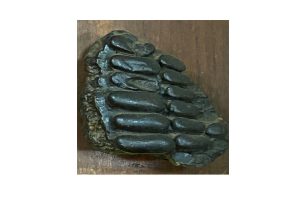Cast of mandible – Pycnodus bowerbunki, Egerton
Phylum: Chordata
Order: Pycnodontiformes
Order: Pycnodontidae
Kingdom : Animalia
Formation : Ypresian, England
Country- United Kingdom
Continent – Europe
Class- Osteichthyes
The right mandible contains three rows of teeth.

- The inner or principle row has five normal teeth in series and a sixth, the anterior one, replaced by what a twin tooth . The twin tooth is divided into a circular denticle , rather irregular, and a crescentic portion embracing the inner periphery of the forms .
- The second series comprises eight teeth, which , although considerably smaller than the principle grinders and are elliptical in form. The outer row contains six teeth very much smaller and nearby circular, the crown or triturating surface of these not yet come into use is irregularly puckered .
Pycnodontiformes, often called Pycodonts , are an extinct order of holostean fishes. These fishes had deep, nearly circular bodies, body armor of jointed rod like scales and mouths containing many pebble like, irregularly arranged crushing teeth. The pebbles like teeth were supposed for being adapted for crushing thin-shelled animals or corals. Pycnodontiformes are known from the Mesozoic of Europe , Asia, Madagascar, Africa, South America and North America . However, they survived into the early Tertiary only in Europe , Asia and Africa.
Gault Formation is a geological Formation of stiff blue clay deposited in a calm, fairly deep-marine environment dining lower Cretaceous period ( upper and Middle Albian age ). It is well exposed in the coastal cliffs. It over lays the Lower Green sand formation and underlies the upper Greensand formations.
The late Cretaceous ( Cenomanian- Maastrichtian) English chalk and Eocene (Ypresian) London clay are two fossiliferous British Marine deposits th
at are significant in the history of palaeontology generally and palaeoichthyology specifically. The actinopterygians ( ray-finned fishes) of the chalk and London clay are notable not diversity, but also for their remarkable preservation. Unlike most fish faunas of comparable age, in which specimens are preserved as greatly flattened compression fossils, these British deposits yield three-dimensionally preserved specimens of either whole individuals (chalk ) or heads(London Clay). The popularity of fossil hunting in the London clay during the mid 1800 s led to James Bowerbank’s foundation of the London clay club(1836-47), which eventually give rise to the modern palaeontographical society. The English chalk and London clay provided ample material for study and description by Arthur Smith Woodward. Natural History Museum,London houses the finest collection of fossil fishes from there localities.
Source
Geological Magazine Decade II , Vol No.2 . February, 1877.
